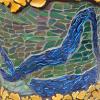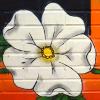Odilon Redon's 'St. Anthony'
GMOA Exhibits the French Symbolist's Lithographs

Plate 18: “Anthony: What is the point of all of this? The Devil: There is no point!”
The temptation of Saint Anthony is an often-repeated theme in Western culture, resurfacing throughout the history of art and literature, as famous names such as Hieronymus Bosch, Salvador Dali and Max Ernst have taken the story as their subject. The tale tells of Saint Anthony the Great, an early Christian ascetic, who after pilgrimaging into the desert at the age of 20 to live as a hermit, endures various supernatural temptations and torments sent by the devil. Most popular in medieval and Renaissance art—as artists became increasingly fascinated with psychology, dreams, spirituality and occult phenomena—Anthony’s struggle also experienced revivals throughout the 19th and 20th centuries. “The Nightmare Transported into Art: Odilon Redon’s ‘St. Anthony,’” an exhibition currently on view at the Georgia Museum of Art, presents a complete set of French symbolist artist Odilon Redon’s lithographs that interpret Gustave Flaubert’s literary masterwork, The Temptation of Saint Anthony.
Though he was a contemporary of Impressionists, Redon shared very little in common with their style that was so much grounded in the surface of the physical world. While Claude Monet—who was born in the same year as Redon, 1840—was focusing on capturing natural sunlight’s glittering effects through softly shaded, pleasant paintings, Redon created “noirs,” charcoal drawings, etchings and lithographs depicting the fantastical creatures of his imagination. Working exclusively in black and white for over two decades, he wholeheartedly embraced the color black with a strong reverence, believing it to be the most effective at communicating the deepest, most ambiguous parts of the unconscious world.
Flaubert, best known for Madame Bovary, spent close to three decades of his life attempting to perfect The Temptation of Saint Anthony. He rewrote the story three times in the form of an impossible play, a style debatably less capable of conveying emotions towards its wild imaginings as strongly as a traditional novel might have been. Loosely basing his rendition on Saint Athanasius’ Life of Saint Anthony of Antioch, written circa 360 CE, Flaubert condenses Anthony’s trials into a single night of terror full of fantastical events. Drawing from his father’s medical texts on mental illness as well as several popular turn-of-the-century ideas such as theories of evolution and interest in religions other than Christianity, his interpretation became a cult object to those interested in altered states of mind.

Plate 13: "...And eyes that without heads were floating like mollusks"
Redon found endless inspiration among the hallucinatory descriptions of bizarre figures in Flaubert’s work, leading him to produce three lithographic albums: two titled “The Temptation of Saint Anthony” in 1888 and 1896—the latter of which is the subject of GMOA’s exhibit—and “To Gustave Flaubert” in 1889. Rather than choosing major plot points, Redon narrows in on the minute moments that made the greatest impression on his imagination. Passages from the text such as “eyes without heads were floating like mollusks” and “the beasts of the sea, round like leather bottles” may have been of lesser importance in the overall text, yet received their own plates within Redon’s series. Under the assumption that the majority of viewers would already be familiar with the story of Saint Anthony, Redon created his lithographs to be evocative, more than illustrative of plot.
Immensely curious about the world beyond the visible, Redon combined his observations of nature—including biological forms seen through a microscope—with thoughts on the supernatural. A precursor to the developing Symbolist movement, Redon sought to create mystical, subjective art exploring the intersections of the physical and spiritual worlds. Though Anthony’s encounters with gods of non-Christian religions are within only one chapter of Flaubert’s book, six of the 24 plates on view at GMOA are dedicated to their image: three Hindu goddesses, Buddha, Cybele, Isis, Apollo and Oannes. Oannes, a Chaldean god who was part man and part fish and described himself as “the first consciousness of chaos, arose from the abyss to harden matter, to regulate forms,” was of particular interest to Redon, likely resonating with his interest in biology and contemplation on the creation of life.
Laura Valeri, associate curator of European art and curator of the exhibition, will lead a tour on Wednesday, Dec. 17 at 2 p.m. “The Nightmare Transported into Art” will remain on view through Sunday, Jan. 25.
More by Jessica Smith
-

Art Around Town
A list of local art exhibits.
-

-

Art Around Town
A list of local art exhibits.









comments